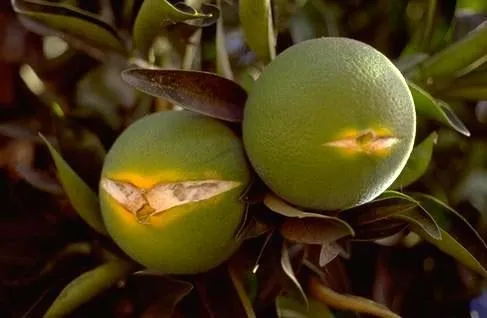Splitting in Navel Oranges is Difficult to Prevent
Splitting of navel oranges is a disorder that shows up every few years in the Northern San Joaquin Valley. It's difficult to predict the problem, and once you see oranges beginning to split, it's too late to do anything about it. However, it may be useful to talk about why splitting may occur, and what you can do to help lessen the problem.
While you may not notice it until the fruit begins to ripen, splitting in navel oranges begins in green fruit. The split usually starts at the stylar or navel end of the fruit, the weakest point in the rind. The split may be short and shallow, or it may be deep and wide, exposing the segments. Splitting is most serious in navel oranges, but it may occur in Valencia oranges too.

It is not well understood just what causes splitting, but it's thought to be caused mainly by a combination of environmental conditions. Some studies show that changes in climate such as temperature and relative humidity may have more effect on splitting than anything else. A couple of my citrus reference books indicate that splitting is caused by hot, dry weather, alternating with humid, cloudy weather. Allowing the soil to dry out too much between irrigations is believed to result in increased splitting. However, other research and observations in orange groves have shown that irrigation, fertilizers and other cultural practices make no difference in the amount of splitting that occurs in any given year.
It is obvious that you cannot control all of the factors that cause splitting, since weather conditions are involved. However, you may be able to minimize the problem by making sure that your orange tree is well watered. Remember that orange trees (as well as other citrus) are not drought tolerant and need a constant supply of moisture in the root zone. If your soil is sandy you may need to water a fully-grown orange tree every ten to fourteen days during the summertime. In clay soils, the watering schedule may be every fourteen to twenty-one days. You should continue to water your trees periodically in fall, at least until rain begins.
Ed Perry is the emeritus Environmental Horticultural Advisor for University of California Cooperative Extension (UCCE) in Stanislaus County where he worked for over 30 years.
